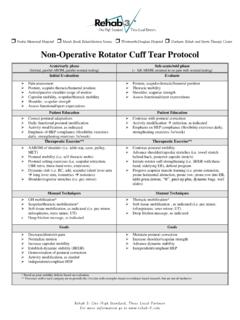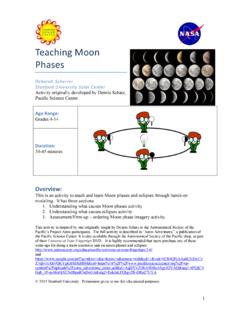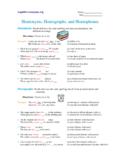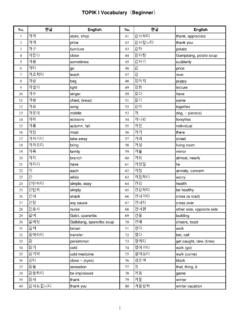Transcription of Man on the Moon (a day in the life of Bob) by Simon Bartram
1 The Centre for Literacy in Primary Education. You may use this teaching sequence freely in your school but it cannot be commercially published or reproduced or used for anything other than educational purposes without the express permission of CLPE. Man on the moon (a day in the life of Bob) by Simon Bartram This humorous book introduces the young reader to Bob s routine existence, which contrasts absurdly with his exotic day job as janitor and tour guide on the moon . The parallel story is shared early on. While Bob emphatically reassures us that there is no such thing as aliens, careful scrutiny reveals these little creatures peeking out from nearly every illustration. Young readers are part of this gradually unfolding conspiracy about which Bob is oblivious.
2 Overall aims of this teaching sequence To explore, interpret and respond to a picture book To explore characters and draw inferences to aid our understanding of them To broaden understanding and use of appropriate vocabulary To write for different purpose about fictional personal experiences To sequence events to write a short narrative based on a known model This teaching sequence is designed for a Year 1 or Year 2 class. Overview of this teaching sequence This teaching sequence is approximately 3 weeks long if spread out over 15 sessions. The book supports teachers to teach about setting, character and plot development. The narrative structure is carefully crafted and the characters and settings are well drawn, offering young readers a good stimulus for their own descriptive and story writing and writing simple non-fiction text types.
3 National Curriculum objectives covered by this sequence Reading: (Word reading / Comprehension) Increase familiarity with a range of books at a level beyond that which they can read independently; Discuss the significance of the title and events; Explain understanding of what is read; Discuss the sequence of events in books; Answer and ask questions; Predict what might happen on the basis of what has been read; Draw inferences on the basis of what is being said and done; Express views about reading. Writing: (Transcription / Composition) Draft and write by composing and rehearsing sentences orally; Sequence sentences to form short narratives; Write for different purposes including about fictional personal experiences and fictional narratives; Reread writing to check it makes sense and make simple revisions; Read writing aloud with appropriate intonation to make the meaning clear.
4 Speaking and Listening: Participate in discussion about what is read, taking turns and listening to what others say; Listen and respond appropriately to adults and peers; The Centre for Literacy in Primary Education. You may use this teaching sequence freely in your school but it cannot be commercially published or reproduced or used for anything other than educational purposes without the express permission of CLPE. Ask relevant questions; Use spoken language to develop understanding through imagining and exploring ideas in discussion, role-play and drama. Cross Curricular Links: This text might be linked to the wider theme of Earth and space. Develop the classroom environment (reading and writing areas) linked to a space theme.
5 Make available a range of related story, information, joke books and appropriate websites; set up a moon souvenir shop and recreate the role-play area as Bob's office on the moon . Within the writing area, provide prompts and writing materials to encourage independent and imaginative responses, for example: drawing materials to make sketches of what Bob can see on the moon ; pads to make lists of equipment needed by Bob; timetables of Bob's day; moon facts; coloured card to create signs for visitors. This area could include digital sound recorders for children to record observations and respond to parts of the story Create small world play opportunities in the classroom: moon landscapes with toy aliens, space ships and astronauts to encourage oral story making and retelling.
6 Science KS1 programmes of study links: Year 1: Everyday materials and Light and Year 2: Uses of everyday materials. Computing Children can be encouraged to produce written outcomes using ICT (see teaching sessions for more detail). KS1 subject content: use technology purposefully to create, organise, store, manipulate and retrieve digital content. Art and design KS1 subject content: generate, develop, model and communicate ideas through talking, drawing, templates, mock-ups and, where appropriate, information and communication technology; select from and use a wide range of materials and components, including construction materials, textiles and ingredients, according to their characteristics.
7 PE: Music and movement activities around spacewalking will help the children understand the weightlessness of Space. Teaching Approaches Reading aloud and rereading Class reading journal Book talk Special questions Drawing and annotating Drama and role-play Visualising Writing in role Writing Outcomes Labelled drawings Captions for labelled drawings Simple recount (postcard) Simple instructions (rules/ signs for moon tourists) Character fact file (or Top Trump card) Writing in role (thought or speech bubbles) The Centre for Literacy in Primary Education. You may use this teaching sequence freely in your school but it cannot be commercially published or reproduced or used for anything other than educational purposes without the express permission of CLPE.
8 Shared writing Story mapping Simple narrative (sequel written from another perspective: A Day in the Life ) Links to other texts and resources Baboon on the moon - British Film Institute Beegu Alexis Deacon Toys in Space - Mini Grey The Way Back Home Oliver Jeffers Wonderful Life Helen Ward Dr Xargle's Book of Earthlings - Jeanne Willis Wanda and the Alien Sue Hendra Weblinks: Earth and moon viewer NASA for kids Teaching Sessions Session 1: Book talk, special questions Prepare a large class reading journal to capture the children s responses and examples of their work throughout the teaching sequence. Display the image of Bob in his front room. Do not share the rest of the book at this point.
9 Though discussion, paired and group work, consider four elements: o What does the picture remind you of? o What do we know about Bob? Would you like to meet Bob? Encourage children to give reasons. o What do you think Bob s hobbies might be? o What would you like to know about Bob? As children share their initial thoughts, scribe responses around the image, labelling any clues children have found about Bob and his hobbies. Through modelling, demonstrate your thinking about Bob and what you would like to know about him. Model orally and in writing how to form a question to ask Bob. In pairs, ask children to think of and compose questions for the character. Share good questions.
10 You may wish for the children to record their question. Make a record of questions on a prepared grid in the class journal. Using shared writing, compose a class letter to Bob and post it along with children's questions. The Centre for Literacy in Primary Education. You may use this teaching sequence freely in your school but it cannot be commercially published or reproduced or used for anything other than educational purposes without the express permission of CLPE. Session 2: Reading aloud, book talk Prepare an envelope containing the book and a letter from Bob thanking the class for their interesting questions and saying that he has sent the book by way of an explanation.





